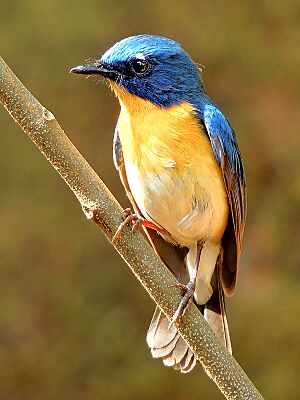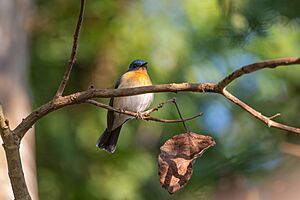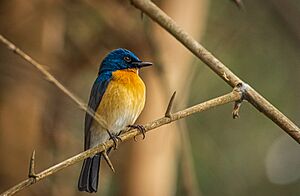Tickell's blue flycatcher facts for kids
Quick facts for kids Tickell's blue-flycatcher |
|
|---|---|
 |
|
| Conservation status | |
| Scientific classification | |
| Genus: |
Cyornis
|
| Species: |
tickelliae
|
| Synonyms | |
|
Muscicapa tickelliae |
|
The Tickell's blue flycatcher (Cyornis tickelliae) is a small, colorful bird. It belongs to the flycatcher family. This bird loves to eat insects. You can find it in warm parts of Asia. This includes places like India, Bangladesh, and Myanmar.
These birds have bright blue backs. Their throats and chests are a reddish-orange color. They live in thick bushes and forests. The bird is named after the wife of Samuel Tickell. He was a British bird expert who studied birds in India.
Contents
What Does It Look Like?
Tickell's blue flycatchers are small birds. They are about 11 to 12 centimeters long. They often sit up straight. They mostly look for food in tall plants and trees.
The male bird has a bright blue back. Its throat and chest are red. The rest of its belly is white. The female bird is a duller blue. But her eyebrows, shoulders, and tail are brighter blue. Young birds look different. They have stripes and spots. Their wings and tail are blue.
These birds sometimes eat even after the sun goes down. They mostly catch flying insects. But they might also pick up crawling insects from the ground.
Where Do They Live?
Tickell's blue flycatchers live in different places. They can be found in dry forests. They also live in bushes, bamboo patches, and gardens.
How Do They Behave?

The song of the Tickell's blue flycatcher sounds like metal. It starts with a few clicks. Then it has five or six clear notes that stop suddenly. When they are worried, they make "churr" sounds and clicking noises.
These birds are a bit shy. But you can often see them even in small gardens. They like places with thick plants and shade. They especially like to be near wooded streams.
They mostly catch insects while flying. But they also eat other insects. This includes termites and earwigs. They might pick these bugs off plants or from the ground. Sometimes, they are seen near garbage areas. During the time they raise their young, they might eat bigger prey. This can even include small animals. A small frog was once seen as food in Sri Lanka.
Reproduction and Life Cycle
The breeding season for these birds is from April to August. In Sri Lanka, it is from March to June. They build their nests in holes. These holes can be in trees or among rocks. They line their nests with soft grass and fibers. Females usually lay 3 to 5 eggs.



